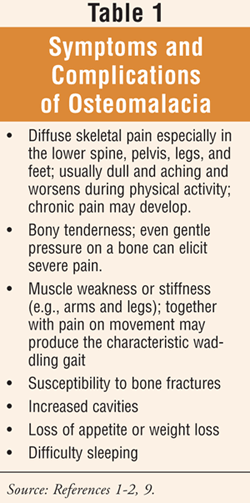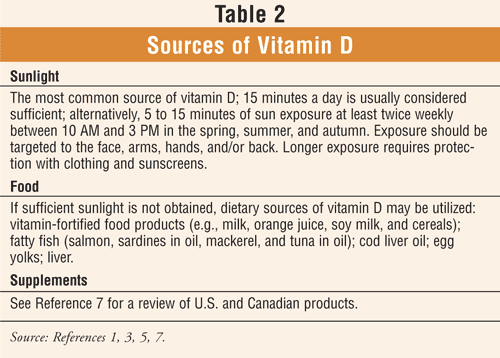Vitamin D Side Effects Bone Pain
Published March 18, 2009
Osteomalacia: Vitamin D Deficiency and Bone Pain
Mary Ann E. Zagaria, PharmD, MS, CGP Recipient of the 2008 Excellence in Geriatric Pharmacy Practice Award from the Commission for Certification in Geriatric Pharmacy.
Senior Care Consultant Pharmacist and President of MZ Associates, Inc.
Norwich, New York, www.mzassociates.com
US Pharm. 2009;34(3):22-24.
Much awareness has been raised regarding the risk of fractures secondary to osteoporosis in seniors. Another condition affecting bones in adults, osteomalacia, is less common than osteoporosis, can be insidious, and may present comorbidly with osteoporosis.1 Whereas osteoporosis is a weakening of previously constructed bone, referred to as porous bone, osteomalacia is deficient bone mineralization, referred to as soft bones.2 Major signs and symptoms of bone demineralization in osteomalacia are achy bone pain and skeletal muscle weakness, fractures, and other complications (TABLE 1).1,2

Osteomalacia is most often caused by a vitamin D deficiency.2 Even though severe vitamin D deficiency is rare in the United States, most Americans do not achieve adequate vitamin D levels from sources that include sunlight, diet, and supplements (TABLE 2).2-4 Approximately 90% of adults between the ages of 51 and 70 do not get enough vitamin D from their diets.3,4

Vitamin D plays an important role in building and protecting bones as it facilitates the absorption of calcium and other minerals in the gastrointestinal (GI) tract; it is responsible for building strong bones in children and for maintaining strong and healthy bones in adults.2,5 Ultimately, vitamin D is responsible for maintaining calcium homeostasis and a serum calcium concentration in an acceptable physiologic range.1,3,6 Studies have revealed that individuals with low vitamin D levels have lower bone density and are at risk for fractures as they age and that seniors may have lower blood levels of vitamin D compared to younger individuals, especially those who have little exposure to sunlight.5,7 Without vitamin D, calcium and other necessary minerals are not as readily absorbed and are therefore unavailable for bone-building mineralization--the process by which these minerals are incorporated into the collagen matrix.2 Vitamin D deficiency causes osteomalacia in adults and rickets (i.e., soft bones, which may bow or fracture) in children.2 Osteomalacia possibly contributes to osteoporosis.8
Causes and Risk Factors of Osteomalacia
Risk factors for osteomalacia include age 50 to 80 years, lactose intolerance with avoidance of vitamin D-fortified milk, and inadequate exposure to the sun.1,2,9 Risk has been known to be highest in those individuals who have both inadequate dietary intake of vitamin D and minimal exposure to sunlight, which is often seen in seniors who are hospitalized, housebound, or residing in long-term-care facilities.2,10
Vitamin D deficiency in the body associated with osteomalacia has many etiologies, including the following:
An Inadequate Supply of Vitamin D from the Diet: Although a diet low in vitamin D is the most common cause of osteomalacia worldwide, it is a less common cause in the United States since many foods are fortified with vitamin D (TABLE 2).2,9
An Inadequate Supply of Vitamin D from Inadequate
Sun Exposure: Since sunlight produces vitamin D in the skin, osteomalacia can develop in individuals who spend inadequate time in sunlight, shield the sun with high sun-protection-factor sunscreen or clothing while outdoors (e.g., in women wearing veiled dresses), or reside in regions with short hours of sunlight (e.g., winter residence in northern climates) or smoggy air.1,2,9
Abnormal Metabolism of Vitamin D: Various mechanisms are responsible for drug-induced osteomalacia associated with anticonvulsant therapy (e.g., phenytoin, phenobarbital, primidone, carbamazepine), rifampin, and some hypnotic agents.1,9 Patients who are institutionalized or those receiving multiple anticonvulsants concomitantly are usually the only individuals in which anticonvulsant-associated osteomalacia is seen. Disorders that alter vitamin D metabolism include kidney failure and primary biliary cirrhosis.2
Surgeries: Surgeries that interfere with the absorption of vitamin D in the GI tract such as the partial or full removal of the stomach (gastrectomy) and removal or bypass of the small intestine.2
Celiac Sprue: An autoimmune disorder that causes small-intestine-lining damage (i.e., secondary to gluten-containing foods such as wheat, barley, and rye), preventing the absorption of vitamin D, among other nutrients.2
Chronic Pancreatitis: Prevents enzymes responsible for food breakdown and subsequent release of nutrients from easily reaching the intestines.2
Conditions Causing Low Blood Levels of Phosphorus: Familial X-linked hypophosphatemia, kidney disorders (e.g., renal tubular acidosis, Faconi syndrome), and tumor-associated osteomalacia.2
Symptoms and Diagnostic Testing
During the early stages of osteomalacia, patients may have no symptoms, although some signs may be seen on x-rays or other diagnostic tests (e.g., bone scan, bone biopsy).2 As the condition worsens, symptoms develop (TABLE 1). Blood and urine tests often detect abnormal levels of vitamin D and the minerals calcium and phosphorus in cases of osteomalacia caused by vitamin D deficiency or by phosphorus loss.2 A serum 25-hydroxyvitamin D (25[OH]D) level should be taken in any individual with limited or no sun exposure, decreased vitamin D intake, or unexplained muscle weakness or pain.1 Levels of 25(OH)D represent body stores of vitamin D and correlate with signs and symptoms of vitamin D deficiency.8 In healthy individuals, levels are 25 to 40 ng/mL (60-100 nmol/L); vitamin D insufficiency (11-20 ng/mL) is distinguished from vitamin D deficiency (<10 ng/mL).1,8
Treatment
The underlying cause of osteomalacia drives the required therapy. The treatment of osteomalacia secondary to vitamin D deficiency is vitamin D supplementation of 800 to 4,000 units/day; alternatively, 50,000 units weekly for eight weeks may be required.1 To treat intestinal malabsorption, high-dose therapy of 50,000 to 100,000 units/day or intramuscular injections of 10,000 units/day may initially be required; a gluten-free diet is necessary for sprue.1 In patients with abnormal vitamin D metabolism (e.g., anticonvulsant-induced osteomalacia), vitamin D supplements of 4,000 units/day may be effective in addition to sun exposure.1 High-dose vitamin D therapy requires monitoring of serum calcium and 25(OH) vitamin D levels.1
Calcitriol (Rocaltrol, Calcijex) may be required in patients who have renal disease with deficient 1,25(OH) vitamin D synthesis as long as serum calcium and creatinine are closely monitored.1,8 Dosing recommendations for vitamin D in patients with stage 3 and 4 chronic kidney disease (CKD) and patients with stage 5 CKD on hemodialysis may be found in Reference 1. When renal tubular acidosis exists with osteomalacia, oral bicarbonate will correct acidosis.1 Phosphate supplements and vitamin D analogues are often used for the treatment of osteomalacia from Fanconi syndrome in addition to treatment for the underlying disorder.1
Prior research suggested that vitamin D3 was a better choice than vitamin D2. However, more recent studies show that supplementation with animal-source vitamin D3 (cholecalciferol) and plant-source vitamin D2 (ergocalciferol [Drisdol]) are equally potent and effective for bone health in oral dosages and are collectively referred to as vitamin D.3,5,6
For a listing of vitamin D and related compounds (oral and parenteral route) including U.S. and Canadian brand names, normal daily recommended intakes in micrograms and units, dosage forms, side effects, and signs of early and late toxicity, please refer to Reference 7 online.7
Special Considerations in Seniors
There is decreased absorption of vitamin D with advancing age.11 Furthermore, research has demonstrated that low serum concentrations of vitamin D result in greater bone loss in geriatric patients who are ill.11 To ensure adequate nutrient intake, nutrient density should be increased since caloric intake decreases with age.11 Because seniors consume less vitamin D and their absorption and sun exposure may be decreased, daily vitamin and mineral supplementation is recommended.11
Vitamin D Adverse Events and Drug Interactions
When doses of vitamin D do not exceed the physiologic requirements, they are usually tolerated well and nontoxic.3 In overdose, however, vitamin D can lead to weakness, vomiting, headache, somnolence, constipation, and weight loss; ongoing vitamin D administration may result in hypercalcemia, which may manifest by deposition of calcium and phosphate into in the kidneys, among other soft tissues.3 An overdose of vitamin D is most likely to occur secondary to an excessive oral intake; any vitamin D3 remaining in the skin gets destroyed by sunlight, so that excess sun exposure is an unlikely cause of overdose of vitamin D.3
A decrease in the GI absorption of vitamin D is seen with cholestyramine, colestipol, orlistat, or prolonged use of mineral oil; separation between the administration of these agents is recommended.3 Barbiturates, carbamazepine, phenytoin, and rifampin increase vitamin D metabolism and may cause decreased concentrations of 25(OH)D and 1,25(OH)2D and increase their metabolism to inactive metabolites; patients may require increased vitamin D supplementation.1,3 Concomitant use of thiazide diuretics and vitamin D may result in hypercalcemia (weakness, headache, somnolence, nausea, rhythm disturbance) in patients with hypoparathyroidism.1
Prevention
Osteomalacia resulting from vitamin D deficiency can be prevented by eating adequate dairy products that have been fortified with vitamin D and by getting enough sunlight.10
If patients suspect their diet may be deficient in vitamin D, they should be instructed about alternate sources of vitamins and minerals.9 Exposure to sunlight should be sufficient, but not excessive; 15 minutes per day is generally considered sufficient, while further exposure requires sun protection with clothing or sunscreens.9 To prevent deficiency, normal daily recommended intake for adults is 200 to 400 units.7 Most seniors require vitamin D supplementation of 400 to 1,000 units/day from sources including multivitamins, combination calcium and vitamin D products, and beverages.1
Conclusion
Pharmacists may play an important role in raising awareness of vitamin D deficiency associated with osteomalacia while appropriately referring patients for evaluation, assisting clinicians and patients with product selection of vitamin D supplements, monitoring for adverse effects and drug interactions, and educating patients and caregivers about bone health and relief from pain and muscle weakness.
REFERENCES
1. O'Connell MB, Seaton TL. Osteoporosis and osteomalacia. In: DiPiro JT, Talbert RL, Yee GC, et al, eds. Pharmacotherapy: A Pathophysiologic Approach, 6th ed. New York, NY: McGraw-Hill Inc; 2005:1645-1669.
2. Osteomalacia. MayoClinic.com. www.mayoclinic.com/health/osteomalacia/DS00935. Accessed January 16, 2009.
3. Changing awareness and management of calcium and vitamin D deficiencies: the role of the pharmacist in bone health and osteoporosis. http://powerpak.com/print.asp?page=courses/105353/
4. Moore C, Murphy MM, Keast DR, et al. Vitamin D intake in the United States. J Am Diet Assoc. 2004;104:9980-9983.
5. Prevention: vitamin D. National Osteoporosis Foundation. www.nof.org/prevention/
6. Reid IR. Clinical aspects of the use of vitamin D and its metabolites. In: Orwoll ES, Bliziotes M, eds. Osteoporosis: Pathophysiology and Clinical Management. Totowa, NJ: Humana Press; 2003:293-307.
7. Vitamin D and related compounds (oral route, parenteral route). MayoClinic.com. Original Article: www.mayoclinic.com/health/
8. Beers MH, Porter RS, Jones TV, et al. The Merck Manual of Diagnosis and Therapy. 18th ed. Whitehouse Station, NJ: Merck Research Laboratories; 2006:41-44,1251.
9. Alan R. Rickets and osteomalacia. www.bidmc. org/YourHealth/ConditionsAZ.
10. Medical Encyclopedia: Osteomalacia. National Library of Medicine. National Institutes of Health. www.nlm.nih.gov/medlineplus/
11. Semla TP, Beizer JL, Higbee MD. Geriatric Dosage Handbook. 14th ed. Hudson, OH: Lexi-Comp, Inc; 2009.
To comment on this article, contact rdavidson@jobson.com.
Vitamin D Side Effects Bone Pain
Source: https://www.uspharmacist.com/article/osteomalacia-vitamin-d-deficiency-and-bone-pain

Tidak ada komentar: